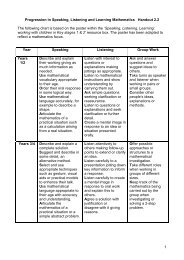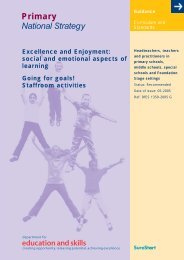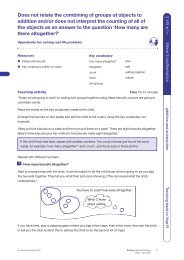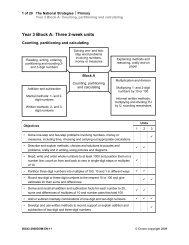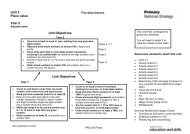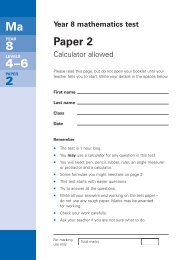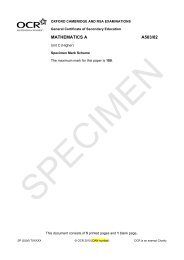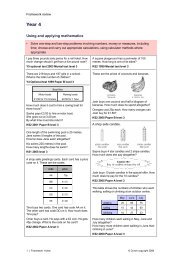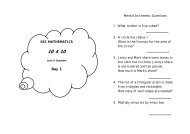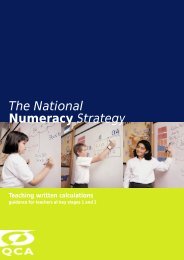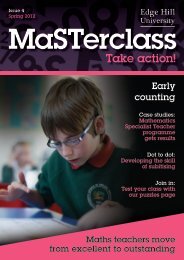Has difficulty in partitioning numbers with zero place holders and/or ...
Has difficulty in partitioning numbers with zero place holders and/or ...
Has difficulty in partitioning numbers with zero place holders and/or ...
You also want an ePaper? Increase the reach of your titles
YUMPU automatically turns print PDFs into web optimized ePapers that Google loves.
<strong>Has</strong> <strong>difficulty</strong> <strong>in</strong> partition<strong>in</strong>g <strong>numbers</strong> <strong>with</strong> <strong>zero</strong> <strong>place</strong><strong>holders</strong> <strong>and</strong>/<strong>or</strong> <strong>numbers</strong> less than one, f<strong>or</strong> examplepartition<strong>in</strong>g 0.45 as 0.4 <strong>and</strong> 0.05Opp<strong>or</strong>tunity f<strong>or</strong>: mak<strong>in</strong>g connectionsResources● Place value boards● Number cards 0–10 (Resource sheet 1)● Several 0 cards● Place value (arrow) cards (<strong>in</strong>clud<strong>in</strong>g decimal<strong>place</strong> value cards)● Place value chart (Resource sheet 39)● Base 10 equipment such as bundles of straws● Calculat<strong>or</strong>● Sticky notesTeach<strong>in</strong>g activityTime 15–20 m<strong>in</strong>utes‘We are go<strong>in</strong>g to th<strong>in</strong>k about some <strong>numbers</strong> that have <strong>zero</strong>s <strong>in</strong> them. Can you tell me a number that hasone <strong>or</strong> m<strong>or</strong>e <strong>zero</strong>s?’‘Let’s make a concept map f<strong>or</strong> <strong>numbers</strong> <strong>with</strong> <strong>zero</strong>s.’Follow on from what the child says.Rec<strong>or</strong>d some <strong>numbers</strong> f<strong>or</strong> the child to name <strong>and</strong> put on a <strong>place</strong> value board us<strong>in</strong>g digit cards, f<strong>or</strong>example 1074 <strong>and</strong> 304.??2002<strong>zero</strong>s areimp<strong>or</strong>tantNumbers <strong>with</strong><strong>zero</strong>s4 0 0 0 is 4 thous<strong>and</strong>Enter the number three hundred <strong>and</strong> four <strong>in</strong>to the calculat<strong>or</strong>.How many hundreds? How many tens? How many ones?Key vocabulary<strong>zero</strong><strong>place</strong> holdercolumnhundredstens10120.04£30.70Thous<strong>and</strong>s Hundreds Tens Units1 0 7 4 1 0 7 41000 70 4units/onesdecimaltenthhundredth3 Y6 /Wave 3 mathematics addition <strong>and</strong> subtraction Track<strong>in</strong>g back to Year 6?Make that number <strong>with</strong> <strong>place</strong> value cards.© Crown copyright 2005 Primary National Strategy I 1DfES 1134-2005
3 Y6 /Use the Place value chart (Resource sheet 39) <strong>and</strong> ask the child to po<strong>in</strong>t to the <strong>numbers</strong> that make up,f<strong>or</strong> example, five hundred <strong>and</strong> three. That is five hundred <strong>and</strong> three. There are no tens.Repeat f<strong>or</strong> the other <strong>numbers</strong>.If the child needs m<strong>or</strong>e supp<strong>or</strong>t, make sure they can partition whole <strong>numbers</strong> us<strong>in</strong>g <strong>place</strong> valuecards. Putt<strong>in</strong>g the <strong>numbers</strong> <strong>in</strong>to a calculat<strong>or</strong> can help to consolidate the child’s underst<strong>and</strong><strong>in</strong>g.???Make a number <strong>with</strong> seven <strong>in</strong> the hundreds, three tens <strong>and</strong> no ones. (730)What if the <strong>zero</strong> was <strong>in</strong> the tens column <strong>and</strong> the three <strong>in</strong> the ones? (703)Is this right?703 = 7 0 + 3Xwrong!???Expla<strong>in</strong> how you know.Shut your eyes <strong>and</strong> try to see a picture <strong>in</strong> your head of seven hundred <strong>and</strong> three made <strong>with</strong>straws. Tell me about the picture.Is seven hundred <strong>and</strong> three m<strong>or</strong>e <strong>or</strong> less than seven hundred <strong>and</strong> thirty?Move on to expl<strong>or</strong>e decimals if appropriate.??What if we re-name the head<strong>in</strong>gs of the <strong>place</strong> value board so that the column on the left isthe tens, then the ones, then there is a decimal po<strong>in</strong>t, then tenths. What would the lastcolumn be f<strong>or</strong>? (Hundredths.)So if we wanted to write down an amount of money such as £5.93, can you put digit cardsonto the <strong>place</strong> value board to show that amount of money?5 0 . 0 30 . 95 0 0£10 £1 10p 1p5 9 3In £1sIn 1ps5 . 9 3 5 9 39 03??What is the value of the three? (Three hundredths – of a pound.)Make five po<strong>in</strong>t n<strong>in</strong>e three <strong>with</strong> <strong>place</strong> value cards. How is it different from five hundred <strong>and</strong>n<strong>in</strong>ety-three?If the child needs m<strong>or</strong>e supp<strong>or</strong>t, use co<strong>in</strong>s on the <strong>place</strong> value board.2 I Primary National Strategy © Crown copyright 2005DfES 1134-2005
??What if we take away the n<strong>in</strong>e 10p co<strong>in</strong>s? What is our amount of money now? (£5.03)How do you know?5 . 0 3 = 5 . 0 33 Y6 /If you are us<strong>in</strong>g a calculat<strong>or</strong> f<strong>or</strong> supp<strong>or</strong>t, <strong>with</strong> 5.93 keyed <strong>in</strong>, ask the child to make the 9 <strong>in</strong>to a 0 <strong>in</strong>one move.‘Let’s write down some of the th<strong>in</strong>gs you learned today <strong>and</strong> some of the th<strong>in</strong>gs you found tricky about<strong>numbers</strong> <strong>with</strong> <strong>zero</strong>s, then we will remember to come back to them next time.’??In the number 60.07 what is the value of the seven? (Seven hundredths.)How many grams are there <strong>in</strong> sixty po<strong>in</strong>t <strong>zero</strong> seven kilograms? (60 070)Spotlight 1<strong>Has</strong> <strong>difficulty</strong> <strong>in</strong> partition<strong>in</strong>g <strong>numbers</strong> <strong>with</strong> <strong>zero</strong> <strong>place</strong> <strong>holders</strong> <strong>and</strong>/<strong>or</strong> <strong>numbers</strong> less than one, f<strong>or</strong>example partition<strong>in</strong>g 0.45 as 0.4 <strong>and</strong> 0.05Opp<strong>or</strong>tunity f<strong>or</strong>: reason<strong>in</strong>g about <strong>numbers</strong> <strong>and</strong> quantitiesExplode a numberTime 10–20 m<strong>in</strong>utesResources● Bundles of straws● Weights● Tape measure <strong>or</strong> metre rules● Number l<strong>in</strong>es● Place value board● Place value (arrow) cards● MoneyKey vocabulary<strong>zero</strong><strong>place</strong> holdercolumnhundredstensunits/onesdecimaltenthhundredthpartitionTeach<strong>in</strong>g activity‘Let’s look at our concept map from last time.’‘Today we are go<strong>in</strong>g to take the number two po<strong>in</strong>t <strong>zero</strong> six <strong>and</strong> we are go<strong>in</strong>g to make that number <strong>in</strong> asmany different ways as we can, so that you will underst<strong>and</strong> m<strong>or</strong>e about decimal <strong>numbers</strong> <strong>with</strong> tenths<strong>and</strong> hundredths.’?Shut your eyes <strong>and</strong> try to make a picture of two po<strong>in</strong>t <strong>zero</strong> six as it is on a <strong>place</strong> value board.Keep your eyes shut <strong>and</strong> tell me about the columns <strong>and</strong> the <strong>numbers</strong>.UnitsTenths Hundredths2 0 6?Look at all the mathematics equipment we have here. F<strong>in</strong>d ways to show two po<strong>in</strong>t <strong>zero</strong> six.© Crown copyright 2005 Primary National Strategy I 3DfES 1134-2005
3 Y6 /You might need to get the child started by, f<strong>or</strong> example, f<strong>in</strong>d<strong>in</strong>g 2 m <strong>and</strong> 6 cm on a tape measure<strong>and</strong> putt<strong>in</strong>g out £2.06 <strong>in</strong> co<strong>in</strong>s.2 . 060 1 2 32 . 11 kg 1 kg 60 g2 m 6 cm£1£11p1p1p1p2 . 061p1p?????Put two po<strong>in</strong>t <strong>zero</strong> six on a number l<strong>in</strong>e.How would you round two po<strong>in</strong>t <strong>zero</strong> six to the nearest whole number? (2)How would you round it to the nearest tenth? (2.1)Which is larger, two po<strong>in</strong>t <strong>zero</strong> six <strong>or</strong> two po<strong>in</strong>t six <strong>zero</strong>? How do you know?Is this c<strong>or</strong>rect? How do you know?2.06 = 2 + 0.06‘Let’s write down some m<strong>or</strong>e th<strong>in</strong>gs you’ve learned about decimal <strong>numbers</strong> on the concept map.’Spotlight 2<strong>Has</strong> <strong>difficulty</strong> <strong>in</strong> partition<strong>in</strong>g <strong>numbers</strong> <strong>with</strong> <strong>zero</strong> <strong>place</strong> <strong>holders</strong> <strong>and</strong>/<strong>or</strong> <strong>numbers</strong> less than one, f<strong>or</strong>example partition<strong>in</strong>g 0.45 as 0.4 <strong>and</strong> 0.05Opp<strong>or</strong>tunity f<strong>or</strong>: recognis<strong>in</strong>g mathematical connectionsIs this right?Time 10–20 m<strong>in</strong>utesResources● Place value (arrow) cards● Calculat<strong>or</strong>Key vocabulary<strong>zero</strong><strong>place</strong> holdercolumnhundredstensunits/onesdecimaltenthhundredthpartition4 I Primary National Strategy © Crown copyright 2005DfES 1134-2005
Teach<strong>in</strong>g activity‘Let’s look at our concept map. Today we are go<strong>in</strong>g to do some m<strong>or</strong>e about whole <strong>and</strong> decimal<strong>numbers</strong> <strong>with</strong> <strong>zero</strong>s <strong>and</strong> mak<strong>in</strong>g those <strong>numbers</strong> <strong>with</strong> <strong>place</strong> value cards. Sometimes I might notpartition the <strong>numbers</strong> c<strong>or</strong>rectly so you must make sure I get it right.’Ask the child to partition 3.6.3 Y6 /??Is it three plus <strong>zero</strong> po<strong>in</strong>t six? (Yes.)How do you know?Make m<strong>or</strong>e <strong>numbers</strong>, sometimes partition<strong>in</strong>g them <strong>in</strong>c<strong>or</strong>rectly.Use a range of equipment that the child likes to w<strong>or</strong>k <strong>with</strong> to clarify ideas.Putt<strong>in</strong>g <strong>numbers</strong> <strong>in</strong>to a calculat<strong>or</strong> <strong>and</strong> talk<strong>in</strong>g about each part added can help. Then ask the childto get rid of one digit of the number at a time.Enter5 0 . 0 6– 50 = 0 . 06–0 . 06 = <strong>zero</strong>14 . 3 = 14 + 0 . 03 No7 . 60 = 7 + 0 . 6 Yes??In the number 0.25, what is the value of the 2? (Two tenths.)If the number was 0.05 why is there a <strong>zero</strong> <strong>in</strong> the tenths? (To hold the <strong>place</strong> to show that thereare no tenths.)‘Now you choose some <strong>numbers</strong> <strong>and</strong> partition them.’?Is there anyth<strong>in</strong>g you want to add to the concept map?‘Make a number that has four <strong>zero</strong>s <strong>in</strong> it <strong>and</strong> a decimal po<strong>in</strong>t. Draw the number partitioned <strong>with</strong> <strong>place</strong>value cards.’Spotlight 3<strong>Has</strong> <strong>difficulty</strong> <strong>in</strong> partition<strong>in</strong>g <strong>numbers</strong> <strong>with</strong> <strong>zero</strong> <strong>place</strong> <strong>holders</strong> <strong>and</strong>/<strong>or</strong> <strong>numbers</strong> less than one, f<strong>or</strong>example partition<strong>in</strong>g 0.45 as 0.4 <strong>and</strong> 0.05Opp<strong>or</strong>tunity f<strong>or</strong>: solv<strong>in</strong>g problems <strong>with</strong> moneyWatch out f<strong>or</strong> red!Time 10–15 m<strong>in</strong>utesResources● St<strong>and</strong>ard 1–6 dice <strong>with</strong> a red sticker on the 6(<strong>or</strong> use the sp<strong>in</strong>ners on Resource sheet 13+)● Money <strong>place</strong> value board f<strong>or</strong> each child <strong>or</strong> pair● £1, 10p <strong>and</strong> 1p co<strong>in</strong>s● At least one other childKey vocabulary<strong>zero</strong><strong>place</strong> holdercolumnhundredstensunits/onesdecimaltenthhundredthpartition© Crown copyright 2005 Primary National Strategy I 5DfES 1134-2005
3 Y6 /Teach<strong>in</strong>g activity‘Today we are go<strong>in</strong>g to play a game called Watch out f<strong>or</strong> red! It will help you to learn m<strong>or</strong>e about <strong>zero</strong>smark<strong>in</strong>g <strong>place</strong>s <strong>in</strong> <strong>numbers</strong> when there is no other digit. It’s called Watch out f<strong>or</strong> red! because if yousp<strong>in</strong> red on the sp<strong>in</strong>ner (<strong>or</strong> throw a red on the dice) you lose all the 1p co<strong>in</strong>s you have, so you must aimto exchange your 1p co<strong>in</strong>s as quickly as possible.’How to play1. The aim of the game is to end up <strong>with</strong> a total of four hundred pence on the board, but this will be <strong>in</strong>£1 co<strong>in</strong>s <strong>and</strong> 10p co<strong>in</strong>s as well as 1p co<strong>in</strong>s.2. Players mustn’t go over four hundred pence <strong>or</strong> they are out!3. Players take turns to sp<strong>in</strong> the sp<strong>in</strong>ner <strong>and</strong> then take the number of co<strong>in</strong>s <strong>in</strong> their sp<strong>in</strong>. Players cantake any comb<strong>in</strong>ation of co<strong>in</strong>s to make the number of co<strong>in</strong>s they sp<strong>in</strong>. So if they sp<strong>in</strong> 4, they couldtake two £1 co<strong>in</strong>s <strong>and</strong> two 10p co<strong>in</strong>s.4. They put their co<strong>in</strong>s on their board <strong>and</strong> must say <strong>and</strong> rec<strong>or</strong>d the number of pence they havealtogether.£10p1p1 0 8?How would I write two hundred <strong>and</strong> twenty pence <strong>in</strong> pounds? (£2.20)5. Each player should keep a runn<strong>in</strong>g total. Remember not to go over four hundred!6. If anyone sp<strong>in</strong>s red, everyone loses all their 1p co<strong>in</strong>s!Make sure the children underst<strong>and</strong> which column co<strong>in</strong>s go <strong>in</strong> as the game goes on.Rem<strong>in</strong>d them that if someone sp<strong>in</strong>s red, everyone will lose all their 1p co<strong>in</strong>s. 10p <strong>and</strong> £1 co<strong>in</strong>s are safe,but not 1p co<strong>in</strong>s, so they must exchange these as soon as they get ten of them.?Have you got enough 1p co<strong>in</strong>s to exchange to get a 10p co<strong>in</strong>? Which column does the 10pgo <strong>in</strong>? Why?If the child has difficulties <strong>with</strong> exchang<strong>in</strong>g 1p co<strong>in</strong>s f<strong>or</strong> a s<strong>in</strong>gle 10p, you could make a strip of tendraw<strong>in</strong>gs of 1p co<strong>in</strong>s <strong>and</strong> encourage the child to put any w<strong>in</strong>n<strong>in</strong>gs of 1p co<strong>in</strong>s on the strip so thatthey can see when they need to exchange.You could rec<strong>or</strong>d f<strong>or</strong> each child how much they have altogether, ask<strong>in</strong>g them to read the <strong>numbers</strong> oftheir runn<strong>in</strong>g total.Eli’s sc<strong>or</strong>e320 + 7+ 3‘How much is f<strong>or</strong>ty-three thous<strong>and</strong> pence? How many 10p co<strong>in</strong>s is that?6 I Primary National Strategy © Crown copyright 2005DfES 1134-2005
Spotlight 4<strong>Has</strong> <strong>difficulty</strong> <strong>in</strong> partition<strong>in</strong>g <strong>numbers</strong> <strong>with</strong> <strong>zero</strong> <strong>place</strong> <strong>holders</strong> <strong>and</strong>/<strong>or</strong> <strong>numbers</strong> less than one, f<strong>or</strong>example partition<strong>in</strong>g 0.45 as 0.4 <strong>and</strong> 0.05Opp<strong>or</strong>tunity f<strong>or</strong>: mak<strong>in</strong>g decisions3 Y6 /Spot the <strong>zero</strong>Time 15–20 m<strong>in</strong>utesResources● Sticky notes● Counters <strong>or</strong> rewards● Place value cardsKey vocabulary<strong>zero</strong><strong>place</strong> holdercolumnhundredstensunits/onesdecimaltenthhundredthpartitionTeach<strong>in</strong>g activity‘We are go<strong>in</strong>g to do some m<strong>or</strong>e w<strong>or</strong>k on <strong>numbers</strong> <strong>with</strong> <strong>zero</strong>s today.’Write some <strong>numbers</strong> <strong>with</strong> <strong>zero</strong>s on sticky notes, f<strong>or</strong> example:2010 6000 790 60.9606 6.09 3030 3.04Put the <strong>numbers</strong> on display.‘I’m go<strong>in</strong>g to choose one of the <strong>numbers</strong> <strong>and</strong> I’m go<strong>in</strong>g to give you a clue about which number it is <strong>and</strong>you have to w<strong>or</strong>k out which number I mean.’??Which number is a three-digit number <strong>with</strong> <strong>zero</strong> <strong>in</strong> the units? (790)How did you know which number to choose?If the child needs supp<strong>or</strong>t, you could ask them to identify all the <strong>numbers</strong> <strong>with</strong> three digits.Also, as the <strong>numbers</strong> are <strong>in</strong>dicated, you could make them <strong>with</strong> <strong>place</strong> value cards.Repeat <strong>with</strong> all the <strong>numbers</strong>; then suggest that you swap roles so they have to write some <strong>numbers</strong><strong>and</strong> give you clues.You are likely to have to supp<strong>or</strong>t w<strong>or</strong>k <strong>with</strong> the decimal <strong>numbers</strong> <strong>with</strong> a <strong>place</strong> value board, <strong>place</strong>value cards, <strong>or</strong> <strong>with</strong> money amounts if you found that helped the child.??What can you tell me about <strong>numbers</strong> <strong>with</strong> <strong>zero</strong>s <strong>in</strong> them?What would you like m<strong>or</strong>e practice <strong>with</strong>?‘Write a number <strong>with</strong> four <strong>zero</strong>s <strong>and</strong> just two other s<strong>in</strong>gle digits, six <strong>and</strong> eight. Are there lots of possible<strong>numbers</strong> <strong>or</strong> just a few?’© Crown copyright 2005 Primary National Strategy I 7DfES 1134-2005
3 Y6 /Spotlight 5: a learn<strong>in</strong>g check<strong>Has</strong> <strong>difficulty</strong> <strong>in</strong> partition<strong>in</strong>g <strong>numbers</strong> <strong>with</strong> <strong>zero</strong> <strong>place</strong> <strong>holders</strong> <strong>and</strong>/<strong>or</strong> <strong>numbers</strong> less than one, f<strong>or</strong>example partition<strong>in</strong>g 0.45 as 0.4 <strong>and</strong> 0.05Opp<strong>or</strong>tunity f<strong>or</strong>: expla<strong>in</strong><strong>in</strong>g <strong>and</strong> discuss<strong>in</strong>gZap the <strong>zero</strong>ResourcesTime 5–15 m<strong>in</strong>utesCheck: does the child use key vocabulary?● One calculat<strong>or</strong> f<strong>or</strong> each pair● At least two children● Numbers on slips of paper that haveone <strong>zero</strong> <strong>in</strong> them (609, 2053, etc.)● TimerTeach<strong>in</strong>g activity<strong>zero</strong><strong>place</strong> holdercolumnhundredstensunits/onesdecimaltenthhundredthpartition‘This game, Zap the <strong>zero</strong>, will help you <strong>with</strong> underst<strong>and</strong><strong>in</strong>g m<strong>or</strong>e about <strong>place</strong> value <strong>and</strong> <strong>numbers</strong> <strong>with</strong><strong>zero</strong> <strong>in</strong> them.’Pairs can cooperate to play this aga<strong>in</strong>st another pair, each pair try<strong>in</strong>g to get their sc<strong>or</strong>e to one wholeone <strong>in</strong> ten m<strong>in</strong>utes.You need to give each child <strong>or</strong> pair some <strong>numbers</strong> <strong>with</strong> <strong>zero</strong>s to get them started, do<strong>in</strong>g this secretly sothe other children don’t hear. F<strong>or</strong> example, one child <strong>or</strong> pair might have the number one thous<strong>and</strong> <strong>and</strong>sixty-three on paper, <strong>and</strong> they must know the name of the number <strong>and</strong> how to key it <strong>in</strong>to the calculat<strong>or</strong>.How to play1. The first child enters a number that has at least one <strong>zero</strong> <strong>in</strong>to the calculat<strong>or</strong>. They must read thenumber c<strong>or</strong>rectly <strong>and</strong> pass the calculat<strong>or</strong> to the other pair <strong>or</strong> child, f<strong>or</strong> example 1063 read as onethous<strong>and</strong> <strong>and</strong> sixty-three.2. The second pair <strong>or</strong> child must <strong>in</strong> one move (either the + <strong>or</strong> – key, a number <strong>and</strong> the = key)make the <strong>zero</strong> become another number.F<strong>or</strong> example, 1063 + 900 would make 1963. The <strong>zero</strong> has disappeared so that second child <strong>or</strong> pairsc<strong>or</strong>e 0.1, but they must also read the number they have made, <strong>in</strong> this case: one thous<strong>and</strong>, n<strong>in</strong>ehundred <strong>and</strong> sixty-three.If this is done c<strong>or</strong>rectly, that pair sc<strong>or</strong>e 0.1.If there is still a <strong>zero</strong> <strong>in</strong> the number, they sc<strong>or</strong>e noth<strong>in</strong>g.3. Then the second pair <strong>or</strong> child enters a different number <strong>with</strong> a <strong>zero</strong> <strong>in</strong> it <strong>and</strong> so on.4. Aim to get a sc<strong>or</strong>e of one whole one (ten tenths) <strong>in</strong> ten m<strong>in</strong>utes.Variations● Play <strong>with</strong> decimal <strong>numbers</strong>. This could be just tenths <strong>or</strong> hundredths as well, f<strong>or</strong> example key<strong>in</strong>g <strong>in</strong> 6.01.● Play <strong>with</strong> <strong>numbers</strong> that have two <strong>zero</strong>s <strong>in</strong> them.Learn<strong>in</strong>g outcomesBy the end of this set of activities, children should be able to:● tackle related learn<strong>in</strong>g tasks <strong>with</strong> <strong>in</strong>creased motivation <strong>and</strong> confidence;● use <strong>and</strong> underst<strong>and</strong> connected mathematical vocabulary;● partition <strong>numbers</strong> <strong>with</strong> <strong>zero</strong> <strong>place</strong> <strong>holders</strong>, <strong>in</strong>clud<strong>in</strong>g decimals <strong>with</strong> tenths <strong>and</strong> hundredths.8 I Primary National Strategy © Crown copyright 2005DfES 1134-2005



